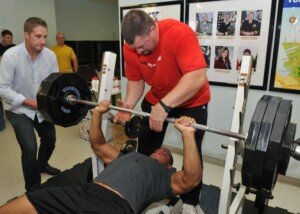Find out what a study determined activates more latissimus muscle: bent-over barbell row or the T-bar style!
So which is better when it comes to building up the lat muscle, the bent-over barbell row or the T-bar version?
According to an electromyography study of men and women who all had at least two years of strength training experience, the bent-over barbell row comes in at 93 percent, and the T-bar row comes in at 89 percent.
What do these numbers mean?
A value of 100 percent means maximum stimulation of muscle fibers. The study was conducted by Tudor O. Bompa, PhD and Lorenzo J. Cornacchia.
In an EMG, electrodes are placed on the muscle area of interest, and muscle activity is recorded as exercise is performed.
The more muscle fiber activation, the greater the potential of gaining strength and mass.
However, EMG results aside, one can understand why the bent-over barbell version is better at lat recruitment than the T-bar row simply by considering how these exercises are done.

Shutterstock/Master1305
In a free-weight T-bar row — in which the tool is an Olympic bar wedged in a corner — the exerciser pulls against the resistance with a hand placement of about shoulder width, using an attached handle.
Sometimes the exerciser has their hands on the barbell, which means an extremely narrow grip.
This subtracts from the activation of the latissimus muscle; more biceps and forearm muscles get involved.
When one uses a cable-machine attachment placed under the bar, this allows the hands to be apart, but it’s still a narrow grip.
In a bent-over barbell row, typically the exerciser uses a wide hand placement.
The wider the hand placement in the grip, the more activation of the latissimus muscle.

embhoo. CreativeCommons
Both exercises are performed while one stands and leans over, so in both cases, there’s core and leg involvement. A striking variable, then, is how far apart the grip is.
However, another variable needs to be considered when pitting the bent-over barbell row against the T-bar: ergonomics and convenience.
Let’s face it; it’s a hassle to set up the corner barbell. In a bent-over row, the weight is already ready to go (if you use a pre-fixed weight), can be done anywhere in the gym.
What about the T-bar row apparatus? Hand placement can be wide.
And the lat muscles are more isolated since the equipment stabilizes the rest of the body.
To be honest, I do not know which version of the T-bar row the study investigated. All I know is that the bent-over barbell row came on top.
The T-bar apparatus is also quite uncomfortable for many, and the fact that the entry and exit of the movement requires lateral shifting of the resistance isn’t exactly inviting. The bent-over barbell row is more comfortable for most people.


























